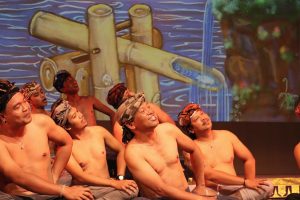Çudamani: Gamelan and Dance of Bali combined several key elements of theatre including dance, music, set, digital projection, and elaborate costuming and makeup. These aspects of the performance served to enhance the dancers and musicians in their telling of the chosen stories. As explained by the Master of Ceremonies, each suite was deeply rooted in cultural tradition and historical significance. To emphasize this, the performers of the dance were all family. Sisters and cousins danced alongside student musicians instilling the importance of oral art forms and cultural inheritance. Further, the company highlighted the work of student musicians. Several of the pieces performed were composed and performed by young musicians who are touring as a part of their apprenticeship with master musicians. The combination of ages and experience truly cultivated intergenerational collaboration and connection.
In Media, Culture, and Identity, this performance allowed us, the audience, to see several important keywords realized on stage in a medium we do not typically have access to. The two that I found most notable in the production were New Media and Feminism.

Çudamani’s use of digital projection can be seen with traditional artwork displayed behind musicians
In the opening piece to the second act, the Master of Ceremonies revealed that the company was experimenting with using digital projection to enhance the performance. Throughout the following pieces, the digital projection showed various images including traditional paintings and images of deities to give further context to the dance. In addition to this, the artwork shown was created by one of the young performers in the cast tying in the focus on cultural upbringing. Here, the use of new media is particularly relevant. Not only was it a new practice for the cast, it is something unheard of in the tradition of the dance. As this dance originates within the 14th-19th centuries, the use of projection is an addition only possible in the modern context.
The final two pieces, the “Tirta” and the “Teruna Jaya”, work to challenge gender norms. Primarily, the dancers are all female, however arguably more important, the “Tirta” is fully choreographed by a woman. This concept, while seemingly a given in modern dance styles, is revolutionary for Balinesian tradition. For many centuries, the performances have been choreographed only

Çudamani’s “Teruna Jaya”
by experienced male dancers, however, the Çudamani company revealed that they are very excited to include this new addition to their repertoire. The “Tirta”, moreover, was performed by all women only reinforcing the importance of the feminine influence on the dance. The “Teruna Jaya” served as another representation of feminism as it is a dance typically performed by only men. In Çudamani’s take, they had a female dancer revel in the spotlight and demonstrate their significant talent.
In the context of media, the recognition of these new additions to the performance further mediates how we view and understand Balinesian tradition. As someone who has never experienced this performance style before, it changed my experience to recognize the historical context of the pieces and the subsequent significance of the additions to the style from the perspective of the Master of Ceremonies. Additionally, my previous understanding of the keywords gave me greater appreciation for the effect of certain elements of the production such as how stylized changes to the traditional performance can enhance the dancers and musicians as well as make the tradition accessible to all audiences.
Photo References:
Cudamani. (2021). Facebook. photograph. Retrieved October 3, 2021, from https://www.facebook.com/SanggarCudamani/.
